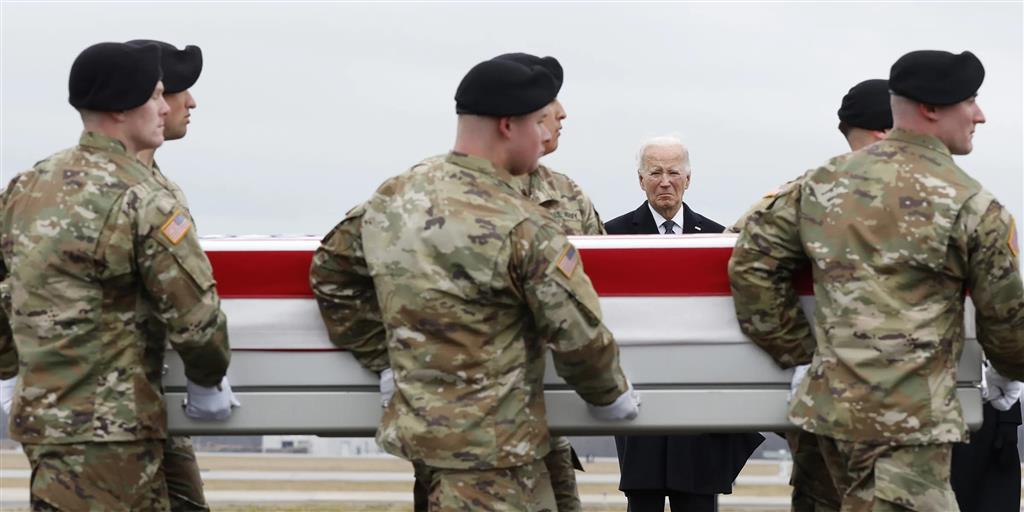By Nick Turse
US troops in Iraq and Syria have come under repeated attack in recent weeks, including a rocket attack on al-Asad Air Base in Iraq on Monday that reportedly injured five US military personnel and contractors. The renewed strikes, which began in July, mark a resumption of a low-level war between America and Iran’s proxies in the Middle East that had ebbed earlier this year.
“We can confirm that there was a suspected rocket attack on August 5th against US and coalition forces at Al Asad Airbase, Iraq,” a spokesperson with US Central Command (CENTCOM), the umbrella organization overseeing the Middle East, told The Intercept by email.
“Base personnel are conducting a post-attack damage assessment.”
The latest attack raises renewed questions about the vulnerability of US bases in the region. Since Israel’s war in Gaza began last October, attacks by Iranian proxy forces on these sites have killed or wounded at least 145 US personnel on Middle Eastern bases.
US and allied forces have been attacked more than 170 times during the Gaza war: 102 times in Syria, 70 in Iraq, and once in Jordan. The latter assault, in January, ignited a round of escalatory US counterattacks against Iranian-allied targets that led Iran to rein in its proxies.
As Israel has widened the Gaza war in recent weeks, with more provocative attacks in Lebanon, Iran, and Yemen, Iran’s partners have resumed attacks on US outposts across the region.
While America’s enemies have demonstrated, to lethal effect, their knowledge of the locations of US bases in the region, the Pentagon’s public affairs office claims to have no list of such outposts. “I don’t have any inherent information,” Defense Department spokesperson Pete Nguyen told The Intercept earlier this year.
CENTCOM refused to comment on the locations of its bases, citing several reasons, including partners’ reluctance to admit to the presence of US troops in their countries. “Our relationship with the host nations is one of the reasons why this information is not made public,” CENTCOM spokesperson Vail A. Forbeck told The Intercept.
Undeterred, The Intercept launched its own investigation and developed a list of more than 60 US bases, garrisons, or shared foreign facilities in the Middle East. These sites range from small combat outposts to massive air bases in 13 countries: Bahrain, Egypt, Iraq, Israel, Jordan, Kuwait, Lebanon, Oman, Qatar, Saudi Arabia, Syria, the United Arab Emirates, and Yemen.
At least 14 of these bases have been attacked in recent years. Since October 17, 2023, alone, a mix of one-way attack drones, rockets, mortars, and close-range ballistic missiles have led to at least 145 US casualties -troops and contractors- at regional outposts including three service members killed in a January drone attack on Tower 22, a facility in Jordan.
“The indefinite US military presences in Iraq, Syria, and around the region have near-zero genuine strategic value for the American people, but DC national security elites still think the risk is well worth it. Those concerned with the well-being of our service members – such as their families- are likely less comfortable with these soldiers being sitting ducks for local militias,” said Erik Sperling of Just Foreign Policy, an advocacy group critical of mainstream Washington foreign policy.
“Americans who are tired of Mideast war should be worried about how these unauthorized hostilities effectively empower regional militias to draw the US into an escalation any time they desire.”
The US has regularly justified maintaining secrecy about bases by claiming that, as CENTCOM told The Intercept last year, “in order to protect our forces and maintain operational security, we will not confirm US base locations.”
Forbeck -a private contractor from the Red Gate Group working for CENTCOM -refused to provide even a count of US bases in the region. “Numbers. Cannot provide that because opsec,” she said, referring to operational security, while failing to explain how providing a simple tally of bases could jeopardize US personnel.
But America’s enemies, specifically Iranian-backed militias, have had no trouble finding and striking US bases since the late 2010s.
Regular tit-for-tat attacks began in January 2020 when Iran’s top general, Qassim Suleimani, was killed near the Baghdad airport in a US drone strike authorized by President Donald Trump. Trump said the US was “totally prepared” for Iran to retaliate -which they did by firing 22 ballistic missiles at two American bases in Iraq.
“All is well!” Trump proclaimed in the wake of the attack, as the US claimed no US troops were killed or wounded. Weeks later, the Pentagon admitted that there were actually 109 US casualties.
Lies by American officials and secrecy surrounding bases in the Middle East has allowed the Pentagon to skirt accountability on several different fronts. US outposts in the region have, for example, become sites of secret sexual assault and a ready source of weapons, ammunition, and equipment for criminals and militants.
Investigations by The Intercept have found, for example, that US outposts in Iraq and Syria are plagued by systematic thefts of military materiel by militias and criminal gangs.
Exclusive documents obtained by The Intercept found that “multiple sensitive weapons and equipment” -including guided missile launch systems, drones, 40mm high-explosive grenades, armor-piercing rounds, and specialized field artillery tools and equipment- have been stolen without comment or announcement by the Pentagon.
Beginning in October 2023, an umbrella group calling itself the Islamic Resistance in Iraq regularly claimed that attacks on US bases in that country were in retaliation for Washington’s support of Israel’s war in Gaza and were aimed at pressuring the US to remove troops from the region.
The attacks dwindled from March to July of this year, but after a July 17 drone attack targeting al-Asad Air Base in Iraq’s Anbar province, where US personnel are deployed, a senior member of the Asaib Ahl al-Haq militia said that attacks by the “resistance factions” had resumed, following a four-month ceasefire, because a deadline given to the Iraqi government to negotiate the departure of US forces from outposts there had expired. (The Iraqi government reportedly wants US troops to begin withdrawing in September and to fully end their work by September 2025.)
The 64 Middle East bases identified by The Intercept have been active in recent years, according to Defense Department information or credible open-source intelligence. But without corroboration by the Pentagon, it’s impossible to know if all remain active today. What is clear are the sizable ongoing US troop deployments in the region.
Despite the US withdrawal from Afghanistan in 2021 and a drawdown of forces in Iraq, there were more than 30,000 US troops stationed in the Middle East in 2023, according to Pentagon figures.
As of June, there were more than 3,800 US military personnel deployed to Jordan “to support Defeat-ISIS operations” and “to enhance Jordan’s security, and to promote regional stability,” according to the White House.
More than 2,300 US troops were stationed in Saudi Arabia to “provide air and missile defense capabilities and support the operation of United States military aircraft.” The US also reportedly has around 2,500 troops deployed to Iraq to “advise, assist, and enable select elements of the Iraqi security forces, including Iraqi Kurdish security forces.”
In addition, around 900 troops are stationed in Syria to “conduct operations, in partnership with local, vetted ground forces, to address continuing terrorist threats emanating from” that country. Approximately 75 US military personnel are also deployed to Lebanon to “enhance the government’s counterterrorism capabilities and to support the counterterrorism operations of Lebanese security forces.”
Numbers of personnel deployed to the Middle East regularly fluctuate. Late last week, Defense Secretary Lloyd Austin ordered additional combat aircraft and warships to the region, in response to threats from Iran and its proxies to attack Israel in the coming days to avenge the death of Hamas political chief Ismail Haniyeh.
Haniyeh was assassinated while visiting Tehran for the inauguration of Iranian President Masoud Pezeshkian. (Hamas, as well as Iranian and US officials, assessed that Israel, which has not publicly acknowledged its responsibility for the killing, was to blame.)
The Pentagon announced plans to send additional Air Force F-22 fighter jets and additional Navy cruisers and destroyers capable of intercepting ballistic missiles to the Middle East. Austin also directed the aircraft carrier USS Abraham Lincoln, now deployed in the Pacific Ocean, to relieve the aircraft carrier USS Theodore Roosevelt, which is already in the region, in the coming weeks.
“When the supreme leader [of Iran] says he’s ‘going to avenge,’ we have to take that seriously. … We got to make darn sure that we’re ready, and we have the capabilities in the region to be able to help Israel defend itself and, quite frankly, defend our own people, our own facilities,” said White House national security communications adviser John Kirby on Fox News Sunday.
Nguyen, the Pentagon spokesperson, failed to respond to more than a dozen requests by The Intercept for updated information about attacks on US troops in the Middle East.





